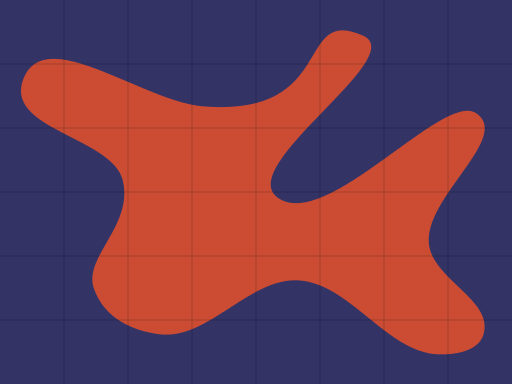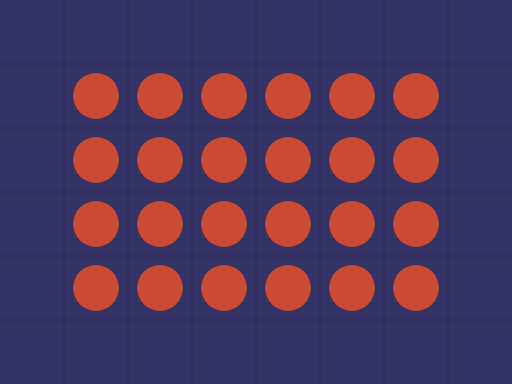Over is not Translucency
The Porter/Duff Over operator, also known as the “Normal” blend mode in Photoshop, computes the amount of light that is reflected when a pixel partially covers another:
The fraction of bg that is covered is denoted alpha. This operator is the correct one to use when the foreground image is an opaque mask that partially covers the background:

A photon that hits this image will be reflected back to your eyes by either the foreground or the background, but not both. For each foreground pixel, the alpha value tells us the probability of each:
$a \cdot \text{fg} + (1 - a) \cdot \text{bg}$
This is the definition of the Porter/Duff Over operator for non-premultiplied pixels.
But if alpha is interpreted as translucency, then the Over operator is not the correct one to use. The Over operator will act as if each pixel is partially covering the background:

Which is not how translucency works. A translucent material reflects some light and lets other light through. The light that is let through is reflected by the background and interacts with the foreground again.
 Let’s look at this in more detail. Please follow along
in the diagram to the right. First with probability
Let’s look at this in more detail. Please follow along
in the diagram to the right. First with probability
$\displaystyle \begin{align*} &a \cdot \text{fg} \end{align*} $
With probability
$\displaystyle \begin{align*} a\cdot \text{fg} &+(1 - a) \cdot \text{bg} \cdot (1 - a) \end{align*} $
But we are not done yet, because with probability
$\displaystyle \begin{align*} a\cdot \text{fg} &+(1 - a) \cdot \text{bg} \cdot (1 - a)\\ &+(1 - a) \cdot \text{bg} \cdot a \cdot \text{fg} \cdot \text{bg} \cdot (1 - a) \end{align*} $
And so on. In each round, we gain another term which is identical to
the previous one, except that it has an additional
$\displaystyle \begin{align*} a\cdot \text{fg} &+(1 - a) \cdot \text{bg} \cdot (1 - a)\\ &+(1 - a) \cdot \text{bg} \cdot a \cdot \text{fg} \cdot \text{bg} \cdot (1 - a)\\ &+(1 - a) \cdot \text{bg} \cdot a \cdot \text{fg} \cdot \text{bg} \cdot a \cdot \text{fg} \cdot \text{bg} \cdot (1 - a) \\ &+\cdots \end{align*} $
or more compactly:
$\displaystyle \begin{align*} &a \cdot \text{fg} + (1 - a)^2 \cdot \text{bg} \cdot \sum_{i=0}^\infty (a \cdot \text{fg} \cdot \text{bg})^i \end{align*} $
Because we are dealing with pixels, both
$\displaystyle \begin{align*} &\sum_{i=0}^\infty x^i = \frac{1}{1 - x} \end{align*} $
Putting them together, we get:
$\displaystyle \begin{align*} &a \cdot \text{fg} + \frac{(1 - a)^2 \cdot bg}{1 - a \cdot \text{fg} \cdot \text{bg}} \end{align*} $
I have sidestepped the issue of premultiplication by assuming that background alpha is 1. The calculations with premultipled colors are similar, and for the color components, the result is simply:
$\displaystyle \begin{align*} &r = \text{fg} + \frac{(1 - a_\text{fg})^2 \cdot \text{bg}}{1 - \text{fg}\cdot\text{bg}} \end{align*} $
The issue of destination alpha is more complicated. With the Over operator, both foreground and background are opaque masks, so the light that survives both has the same color as the input light. With translucency, the transmitted light has a different color, which means the resulting alpha value must in principle be different for each color component. But that’s not possible for ARGB pixels. A similar argument to the above shows that the resulting alpha value would be:
$\displaystyle \begin{align*} &r = 1 - \frac{(1 - a)\cdot (1 - b)}{1 - \text{fg} \cdot \text{bg}} \end{align*} $
where
$\displaystyle \begin{align*} &r = 1 - \frac{(1 - a)\cdot (1 - b)}{1 - a \cdot b} \end{align*} $
which is equal to
$\displaystyle \begin{align*} &a + \frac{(1 - a)^2 \cdot b}{1 - a \cdot b} \end{align*} $
Ie., exactly the same computation as the one for the color channels. So we can define the Translucency Operator as this:
$\displaystyle \begin{align*} r = \text{fg} + \frac{(1 - a)^2 \cdot \text{bg}}{1 - \text{fg} \cdot \text{bg}} \end{align*} $
for all four channels.
Here is an example of what the operator looks like. The image below is what you will get if you use the Over operator to implement a selection rectangle. Mouse over to see what it would look like if you used the Translucency operator.
Both were computed in linear RGB. Typical implementations will often compute the Over operator in sRGB, so that’s what see if you actually select some icons in Nautilus. If you want to compare all three, open these in tabs:
And for good measure, even though it makes zero sense to do this,

